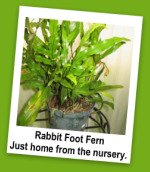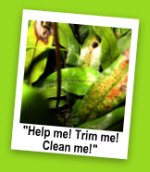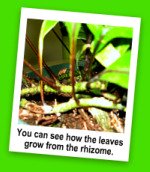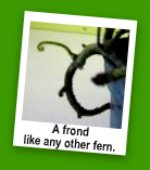Rabbit Foot Fern
a.k.a., Wart Fern - Serpent or Snake Fern
Maile-Scented Fern (Hawaii)
Polypodiaceae Microsorum scolopendria
Polypodium scolopendria
The Rabbit Foot Fern is one of the most interesting plants I've ever come across.
Not to be confused with the other rabbit's foot fern, Davallia fejeensis, this one sports green rhizomes with brown "hairs" that crawl like serpents across the top of the soil and around the sides of the pot or basket.
These are what give the plant two of its names.
The leaves are bright green and leathery; some are simply elongated and others grow with deep clefts, reminding you of an oak leaf or fingers.
Under the leaves, spore clusters push upwards, creating "warts": hence, its other name of Wart Fern.
This is a good plant for both the beginning and the expert Indoor Gardener.

Easy to grow, hard to kill, this creeping epiphyte is not that easy to find. If you see it, grab it up quickly!
It grows in small to large pots, gets along well with other plants, and will grow right up a tall plant or stake without harming them.
The Rabbit Foot Fern has enough odd attributes and strange behaviors to give the Indoor Gardener plenty to talk about.
| Batya's Personal Notes: (08-2010) I just couldn't resist the Wart or Rabbit Foot Fern, which I found sitting alone at my favorite nursery. Between the oaklike shape of the leaves, the forest-green color, the spores, and the rhizomes - which kind of creep me out in a fascinating way - I just had to have one!  Once they said it needed a little morning sun - of which I have plenty with an East-facing kitchen window - and little other care, well, what Indoor Gardener wouldn't take the little guy home? You'll see my photos on this page. He needed a little trimming back, as some of the leaves were damaged, though there were no visible bugs. (That particular nursery is great: no bugs, great soil, fair prices, knowledge, happy plants.) I washed down the leaves, also, very gently, and then re-potted him about an inch or two up. |
For the Indoor Gardener
CARE / SPECIAL NEEDS
- Light: Morning sun; full - partial - light shade rest of day
- Water: Warm; keep lightly moist
- Soil: Rich; can use African violet mix
- Humity: High
- Misting: Warm, lime-free water; occasionally
- Fertilizer: Weekly, at 50% strength; liquid
- Temp: 60-85 degrees

MAXIMUM DIMENSIONS
- Height: 3+ ft high
- Width: leaves: 10"-16"
HEALTH: Watch for mealy bugs
COST: varies greatly
Prices for the Rabbit Foot Fern can vary. It's not a common find in larger home-goods garden shops so it can get pricey. However, if you know someone who's used Wart Fern for landscaping where it grows fast and spreads out quite a bit, you can divide it to take some indoors. I found the last one at my nursery for a mere $5 for a 6" pot, so the cost can also be fairly low.
PROPAGATION
- Natural: Sori (spore-holding structures) under the leaves
- Houseplant: Divide (easy), or by spores (more complicated)
FLOWERS: None
FRIENDLINESS FACTOR: Cozy, huggy
If you have a palm or other plant with a trunk, trellises, or an indoor brick wall, the Rabbit Foot Fern will grow right up them, without doing any damage or being a bother at all.
On the other hand, you don't want to mix a Wart Fern in the same basket as anything else needing access to the surface of the soil, or anything else needing the over-the-edge draping area.
The fern was not included on lists of plants poisonous to pets that were consulted.

CONVERSATION VALUE: High
- Leaves
- Spores
- Rhizomes
DECORATION SUGGESTIONS:
- Large or small pots
- Hanging baskets - rhizomes crawl down the sides
- If you have an area that needs something tall and interesting, but you don't want a ficus, palm, or tree, encourage the Rabbit Foot Fern to grow up a tall trellis or stake. The hair-covered rhizomes will grab on naturally
MEDICINAL VALUE: Click Here to Read Disclaimer
- Absesses - paste of ground leaves and earth (best from a wasp's nest)
- Wounds - leaf pulp dressing
- Insanity - drink water with ground leaves mixed in
OTHER USES:
In Hawaii, the leaves are picked and then dried. As they age they develop a light, vanilla-like fragrance that freshens just-folded laundry

For Botanists, Scientists,
Outdoor Gardeners, and School Reports
ORIGIN: Old World tropics
The Rabbit Foot Fern grows naturally in tropical Africa, Madagascar, Taiwan, China, India, Southeast Asia, Polynesia, and northeast Australia.
It favors dune forests and coastal scrub forests as well as upland temperate or tropical evergreen forests. The Wart Fern's favorite habitat remains coastal areas at sea level to about 6,234 feet (1,900 meters) altitude.

NATURAL GROWTH (OUTDOORS)
- ground cover
- climbs rocks
- climbs sides of trees/plants
- covers brick walls
- grows on old stone walls
- leaves can grow to 12 inches or longer
CATEGORIZATION:
Polypodiaceae Microsorum (or Phymatosorus) scolopendria
About 540 species and 30 genera of the fern have been counted. Most grow on soil, some grow as epiphytes or lithophytes.
-
DOMAIN: Eukaryota
KINGDOM: Plantae
SUBKINGDOM: Viridaeplantae
PHYLUM: Euphyllophytina
INFRAPHYLUM: Moniliformopses
CLASS: Filicopsida
ORDER: Filicales
FAMILY: Polypodiaceae
TRIBE: Indigo fereae
GENUS: Microsorum (or Phymatosorus)
SPECIES: scolopendria
People who like the Rabbit Foot Fern
also like the Staghorn Fern
.
Click here to read our Disclosure Statement
Click the image to ORDER and get more information

A great way to grow and display the Staghorn Fern
is with one already mounted and ready to hang on your wall -- indoors or out! It does need light, so place it near a window. And remember to put plastic or a towel under it when you water its root clump!
DISCLAIMER: Indoor-Gardener.com reports information from research and does not guarantee any of the plants mentioned, for medicinal, decorative, or other uses. Neither the FDA nor any physician have endorsed the uses of plants mentioned on the website. Use plants as food or medicinal products only at your own risk.
Return from Rabbit Foot Fern to
Indoor Gardener Home Page



